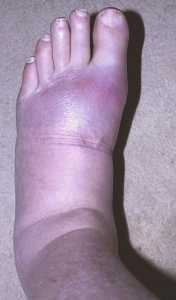Dysplastic Moles Not Necessarily Precursor to Melanoma But Indicate Increased Risk
MidLife PSA Can Risk-Stratify Prostate Cancer in African American Men
We demonstrated that PSA levels in midlife very strongly predict future aggressive prostate cancer. ...
Cutting Out Bacon, Sausage and Hot Dogs May Reduce Risk of Breast Cancer
 Maryam Farvid, Ph.D., Research Scientist
Department of Nutrition
Harvard T.H. Chan School of Public Health
Boston, MA 02115
MedicalResearch.com: What is the background for this study? What are the main findings?
Response: Prior prospective studies on red and processed meat consumption with risk of breast cancer have produced inconsistent results.
Current meta-analysis of 15 prospective studies shows that women who eat a high amount of processed meat each day may have a higher risk of breast cancer than those who don't eat or have a low intake in their diet. (more…)
Maryam Farvid, Ph.D., Research Scientist
Department of Nutrition
Harvard T.H. Chan School of Public Health
Boston, MA 02115
MedicalResearch.com: What is the background for this study? What are the main findings?
Response: Prior prospective studies on red and processed meat consumption with risk of breast cancer have produced inconsistent results.
Current meta-analysis of 15 prospective studies shows that women who eat a high amount of processed meat each day may have a higher risk of breast cancer than those who don't eat or have a low intake in their diet. (more…)Gene Variants Can Alter Glucose Absorption and Cardiometabolic Risks
Insufficient Sleep in Adolescence May Be A Driver of Risky Behaviors
Genetic Risk Score Improves Ability To Predict Diabetics at Risk of Coronary Disease
MedicalResearch.com Interview with: [caption id="attachment_44905" align="alignleft" width="200"] Dr. Morieri[/caption] Mario Luca Morieri MD Section on Genetics and Epidemiology, Research Division, Joslin Diabetes Center Department...
What Types of Health Care Records Are Breached?
MedicalResearch.com Interview with: [caption id="attachment_44776" align="alignleft" width="200"] Dr. McCoy[/caption] Thomas McCoy, M.D. Assistant Professor of Psychiatry Massachusetts General Hospital Psychiatry Massachusetts General Hospital MedicalResearch.com: What is the...
Cardiac Stimulant Found in Some OTC Supplements
Combination Brand Name Drugs Cost Medicare Millions More Than Separate Generic Pills
Why Do So Few Women Enter or Complete Surgical Residency?
When It Comes to LDL-C, “You Really Can’t Be Too Low”
Sexual Minorities More Likely To Be Unemployed and Uninsured
Changing One Gene in One Gut Bacteria Altered Metabolism and Weight Gain (in mice)
Opioid Prescription Rates Higher in South, Appalachia and Rural West
The main findings are high prescribing rate districts are concentrated in the South, Appalachia and the rural West. Low-rate districts are...
Medical Notes Using Speech Recognition: Less Than Perfect
Women With History of Preeclampsia or Gestational Hypertension Have Increased Risk of Cardiovascular Disease
PD-1 Inhibitors Appear to Improve Overall Survival More than Progression-Free Cancer
Voluntary Bundled Payment Program For Care After Acute Hospitalization Unable to Achieve Broad Participation
Cardiovascular Risk and Gout Treatment: Febuxostat v. Allopurinol
 Seoyoung C. Kim, MD, ScD, MSCE
Associate Professor of Medicine
Division of Pharmacoepidemiology & Pharmacoeconomics
Division of Rheumatology, Immunology and Allergy
Brigham and Women's Hospital, Harvard Medical School
MedicalResearch.com: What is the background for this study? What are the main findings?
Response: Since patients with gout are at an increased risk of cardiovascular events, we wanted to examine comparative cardiovascular safety of the two most commonly used urate-lowering drugs – febuxostat and allopurinol.
Using claims data from US Medicare, we conducted a cohort study of 24,936 febuxostat initiators PS-matched to 74,808 allopurinol initiators.
We found the risk of the primary cardiovascular endpoint (MI or stroke) was similar between the two groups. Analyses on secondary endpoints as well as all-cause mortality showed similar findings except that febuxostat was associated with a modestly reduced risk of heart failure exacerbation among patients with preexisting heart failure. In our sensitivity analysis, the risk of all-cause mortality associated with long-term use of febuxostat v. allopurinol appears to be increased but statistically not significant.
(more…)
Seoyoung C. Kim, MD, ScD, MSCE
Associate Professor of Medicine
Division of Pharmacoepidemiology & Pharmacoeconomics
Division of Rheumatology, Immunology and Allergy
Brigham and Women's Hospital, Harvard Medical School
MedicalResearch.com: What is the background for this study? What are the main findings?
Response: Since patients with gout are at an increased risk of cardiovascular events, we wanted to examine comparative cardiovascular safety of the two most commonly used urate-lowering drugs – febuxostat and allopurinol.
Using claims data from US Medicare, we conducted a cohort study of 24,936 febuxostat initiators PS-matched to 74,808 allopurinol initiators.
We found the risk of the primary cardiovascular endpoint (MI or stroke) was similar between the two groups. Analyses on secondary endpoints as well as all-cause mortality showed similar findings except that febuxostat was associated with a modestly reduced risk of heart failure exacerbation among patients with preexisting heart failure. In our sensitivity analysis, the risk of all-cause mortality associated with long-term use of febuxostat v. allopurinol appears to be increased but statistically not significant.
(more…)Developing a Pill That Mimics Effects of Gastric Bypass Surgery
- The type-2 diabetes (T2D) epidemic will affect over 642 million people worldwide by 2040. As a result, diabetes costs the US healthcare over $174 billion dollars annually and is the leading cause of blindness, amputations, renal failure, and poor cardiovascular outcomes. Recently, bariatric surgery, bypassing stomach and intestine from the food stream, has shown promising results and shown to be superior to pharmaceuticals in managing T2D. However, the risks of surgery along with permanent changes to gastrointestinal anatomy deters many suitable patients from surgery, with less than 1-2% of Americans who qualify for weight loss surgery actually undergoing the procedure. Therefore, there is an urgent need for a safe, non-invasive and effective treatment for wider diabetic patient population.
- We envisioned a pill that a patient can take before a meal that transiently coats the gut to replicate the effects of surgery. During the past 8 years, we’ve been working on this idea and have developed a safe gut-coating material that can potentially mimic the beneficial effects of gastric bypass procedures in the form a pill.
- LuCI can be activated in any part of gastrointestinal tract (e.g. stomach, duodenum, intestine, colon) to form a temporary physical barrier that isolates that part of gastrointestinal tract. In our pre-clinical models, LuCI coated the duodenum to modulate glucose responses in oral glucose tolerance tests.
- These beneficial effect are observed without any evidence of systemic absorption of the drug.
- We believe that LuCI could be a new therapeutic approach for T2D that is based on Roux-en-Y gastric bypass surgery, but is safer, associated with significantly less complications, and thus can potentially help a wide T2D patient population.
- In a separate set of studies, we also showed that luCi allows delivery of certain proteins and drugs, which would normally be degraded by the gastric acid, to the GI tract, protecting it from gastric acid digestion and prolonging their luminal exposure.
No Link Found Between Caesarean Delivery and Childhood Obesity
Organ Transplant Recipients Require Vigilant Sun Protection
 Rebecca Ivy Hartman, M.D
Instructor in Dermatology
Brigham and Women's Hospital
Boston MA 02115
MedicalResearch.com: What is the background for this study? What are the main findings?
Response: Organ transplant recipients (OTR) are at 100-fold higher risk to develop certain skin cancers compared to the general population due to immunosuppression, and thus preventing skin cancer in this population is critical.
Our study found that in a high-risk Australian OTR population, only half of patients practiced multiple measures of sun protection regularly.
However, after participating in a research study that required dermatology visits, patients were over 4-times more likely to report using multiple measures of sun protection regularly. Patients were more likely to have a positive behavioral change if they did not already undergo annual skin cancer screening prior to study participation.
(more…)
Rebecca Ivy Hartman, M.D
Instructor in Dermatology
Brigham and Women's Hospital
Boston MA 02115
MedicalResearch.com: What is the background for this study? What are the main findings?
Response: Organ transplant recipients (OTR) are at 100-fold higher risk to develop certain skin cancers compared to the general population due to immunosuppression, and thus preventing skin cancer in this population is critical.
Our study found that in a high-risk Australian OTR population, only half of patients practiced multiple measures of sun protection regularly.
However, after participating in a research study that required dermatology visits, patients were over 4-times more likely to report using multiple measures of sun protection regularly. Patients were more likely to have a positive behavioral change if they did not already undergo annual skin cancer screening prior to study participation.
(more…)First in Class Antibody-Drug Conjugate Shows Promise in Metastatic Breast Cancer
Sciatica: Biomarker Demonstrates Inflammation, Not Just Compression of Nerve Roots
 Daniel Albrecht, PhD
Research Fellow in Radiology, Harvard Medical School
Research Fellow, Massachusetts General Hospital
MedicalResearch.com: What is the background for this study? What are the main findings?
Response: A great deal of preclinical work in animal models of pain has established that activation of peripheral immune cells or, in the central nervous system (brain and spinal cord), immune cells called “glia” (microglia and astrocytes) play a key role in the establishment and/or maintenance of persistent pain. For instance, if you pharmacologically block activation of these cells in the nervous system, you are able to reduce/inhibit/prevent pain behaviors, e.g. in animals who have received a nerve injury.
This observation is very exciting, because it suggests that blocking neuroinflammation may be a viable way of treating pain. However, the evidence linking human chronic pain with neuroinflammation has so far been limited.
In this study we show, for the first time, that patients with chronic sciatica (that is, back pain that shoots down the leg) demonstrate elevations in the levels of a protein called the translocator protein (TSPO) in the spinal cord and in the nerve roots.
Because TSPO is a marker of neuroinflammation, our results suggest that sciatica is associated with neuroinflammation.
While on average patients do show elevations in the levels of the TSPO, we also saw significant variability across individuals. Importantly, patients that show stronger elevations (in the nerve roots) were those who benefit the most from receiving a local anti-inflammatory treatment (epidural spinal injection). This makes sense: patients whose nerve roots are inflamed benefit from an anti-inflammatory treatment. Those whose nerve roots aren’t inflamed, don’t receive the same benefit. In the latter case, the source of the inflammation and pain may not be the nerve roots, but may be the spinal cord, or, as we showed in a previous paper (Loggia et al., Brain 2015), the brain. (more…)
Daniel Albrecht, PhD
Research Fellow in Radiology, Harvard Medical School
Research Fellow, Massachusetts General Hospital
MedicalResearch.com: What is the background for this study? What are the main findings?
Response: A great deal of preclinical work in animal models of pain has established that activation of peripheral immune cells or, in the central nervous system (brain and spinal cord), immune cells called “glia” (microglia and astrocytes) play a key role in the establishment and/or maintenance of persistent pain. For instance, if you pharmacologically block activation of these cells in the nervous system, you are able to reduce/inhibit/prevent pain behaviors, e.g. in animals who have received a nerve injury.
This observation is very exciting, because it suggests that blocking neuroinflammation may be a viable way of treating pain. However, the evidence linking human chronic pain with neuroinflammation has so far been limited.
In this study we show, for the first time, that patients with chronic sciatica (that is, back pain that shoots down the leg) demonstrate elevations in the levels of a protein called the translocator protein (TSPO) in the spinal cord and in the nerve roots.
Because TSPO is a marker of neuroinflammation, our results suggest that sciatica is associated with neuroinflammation.
While on average patients do show elevations in the levels of the TSPO, we also saw significant variability across individuals. Importantly, patients that show stronger elevations (in the nerve roots) were those who benefit the most from receiving a local anti-inflammatory treatment (epidural spinal injection). This makes sense: patients whose nerve roots are inflamed benefit from an anti-inflammatory treatment. Those whose nerve roots aren’t inflamed, don’t receive the same benefit. In the latter case, the source of the inflammation and pain may not be the nerve roots, but may be the spinal cord, or, as we showed in a previous paper (Loggia et al., Brain 2015), the brain. (more…)Women and Uninsured More Likely to Suffer from Migraines
What’s the Prognosis If You Get Breast Cancer After a Negative Mammogram?
Healthy Lifestyle Keys to a Longer Life
MedicalResearch.com Interview with: Yanping Li PhD, Research Scientist Department of Nutrition Harvard T.H. Chan School of Public Health MedicalResearch.com: What is the background for...



















